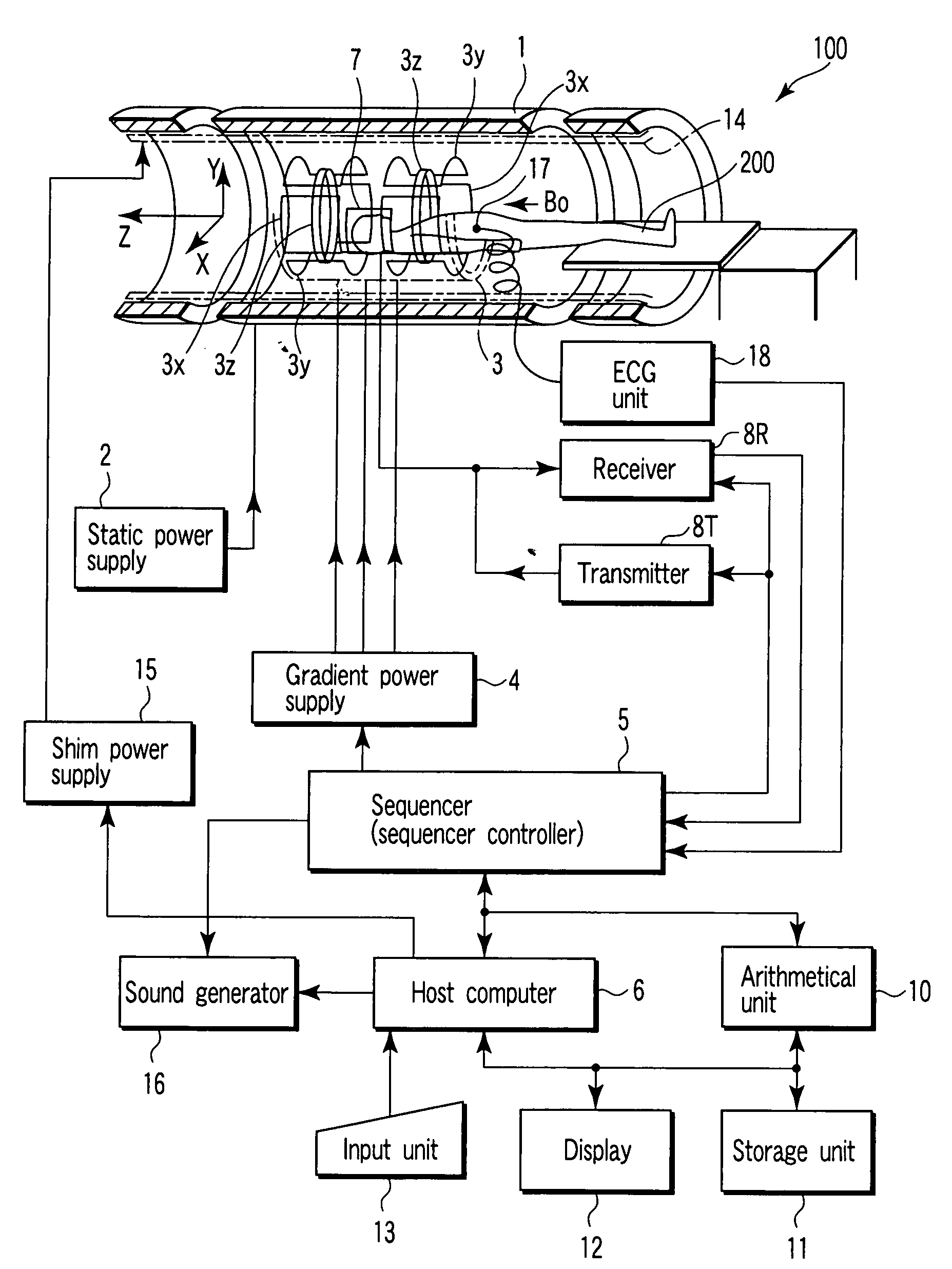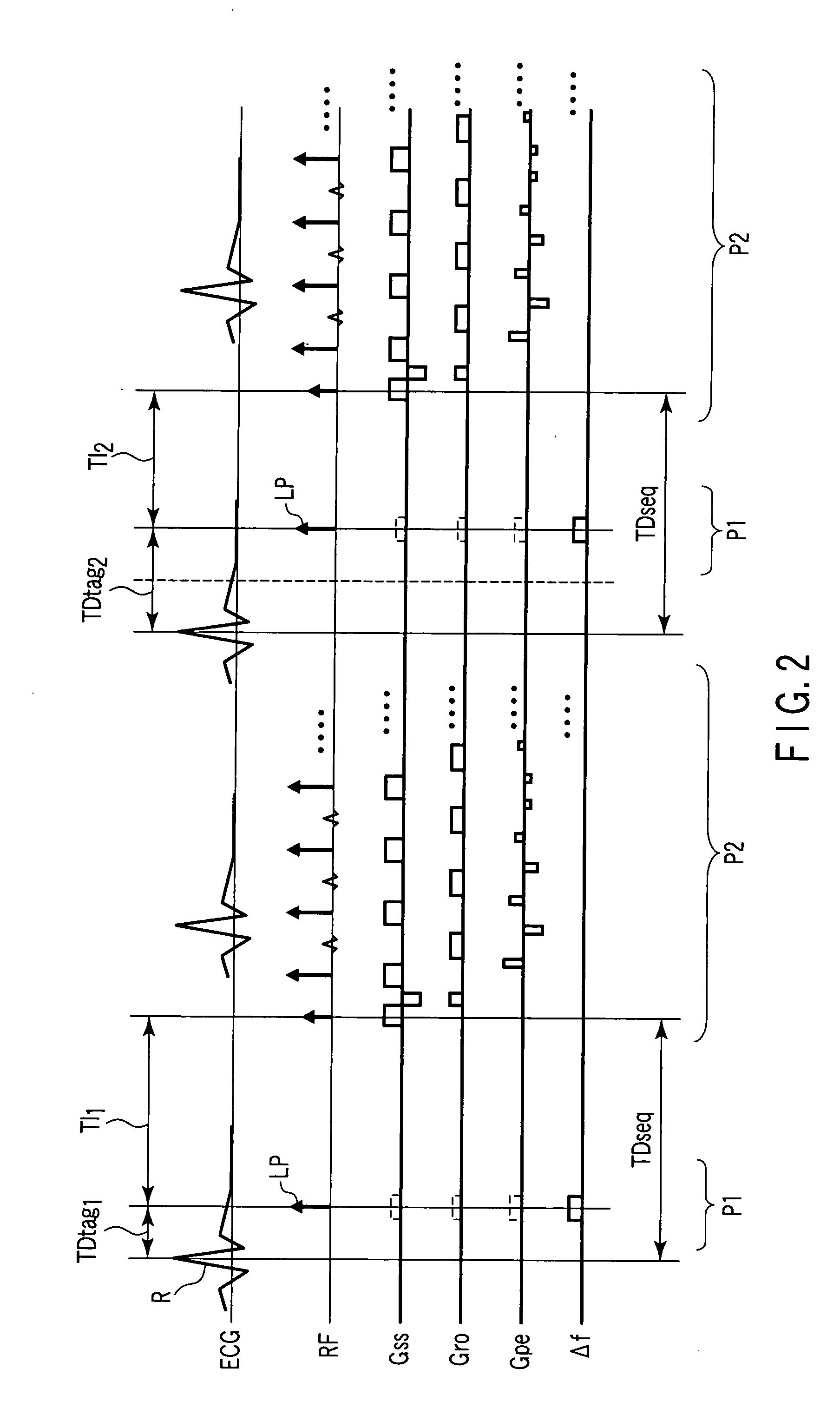Magnetic resonance imaging apparatus and magnetic resonance imaging method
- Summary
- Abstract
- Description
- Claims
- Application Information
AI Technical Summary
Benefits of technology
Problems solved by technology
Method used
Image
Examples
first embodiment
[0082]The first embodiment is described below. The first embodiment corresponds to First Problem.
[0083]FIG. 2 is a diagram showing a pulse sequence in the first embodiment. Waveforms shown in FIG. 2 represent, from top to bottom, an ECG as a synchronization waveform, a radio-frequency (RF) pulse applied to an imaging target, a slice direction gradient magnetic field waveform (Gss), a readout direction gradient magnetic field waveform (Gro), a phase encoding direction gradient magnetic field waveform (Gpe), and a deviation (Δf) of a carrier wave from a center frequency during the application of the radio-frequency pulse. A period P1 is a tag sequence part for labeling blood or cerebrospinal fluid. A period P2 is a main pulse sequence part for imaging. Although a fast spin echo method is employed in this example, it is possible to use any imaging method such as the coherent gradient echo method (the true SSFP method, true FISP or balanced FFE method).
[0084]As apparent from a compariso...
second embodiment
[0097]The second embodiment is described below. The second embodiment corresponds to Second Problem.
[0098]FIG. 5 is a diagram showing a pulse sequence in the second embodiment. Waveforms shown in FIG. 5 represent, from top to bottom, a cerebrospinal fluid pulsation waveform as a synchronization waveform, a radio-frequency (RF) pulse applied to an imaging target, a slice direction gradient magnetic field waveform (Gss), a readout direction gradient magnetic field waveform (Gro), a phase encoding direction gradient magnetic field waveform (Gpe), and a deviation (Δf) of a carrier wave from a center frequency during the application of the radio-frequency pulse. A period P1 is a tag sequence part for labeling blood or cerebrospinal fluid. A period P2 is a main pulse sequence part for imaging. Although the fast spin echo method is employed in this example, it is possible to use any imaging method such as the coherent gradient echo method (the true SSFP method, true FISP or balanced FFE me...
third embodiment
[0114]The third embodiment is described below. The third embodiment corresponds to Second Problem.
[0115]FIG. 11 is a diagram showing a pulse sequence in the third embodiment. Waveforms shown in FIG. 11 represent, from top to bottom, an electrocardiograph (ECG) as a synchronization waveform, a radio-frequency (RF) pulse applied to an imaging target, a slice direction gradient magnetic field waveform (Gss), a readout direction gradient magnetic field waveform (Gro), a phase encoding direction gradient magnetic field waveform (Gpe), and a deviation (Δf) of a carrier wave from a center frequency during the application of the radio-frequency pulse. A period P1 is a tag sequence part for labeling blood or cerebrospinal fluid. A period P2 is a main pulse sequence part for imaging. Although a fast spin echo method is employed in this example, it is possible to use any imaging method such as the coherent gradient echo method (the true SSFP method, true FISP or balanced FFE method).
[0116]As a...
PUM
 Login to View More
Login to View More Abstract
Description
Claims
Application Information
 Login to View More
Login to View More - R&D
- Intellectual Property
- Life Sciences
- Materials
- Tech Scout
- Unparalleled Data Quality
- Higher Quality Content
- 60% Fewer Hallucinations
Browse by: Latest US Patents, China's latest patents, Technical Efficacy Thesaurus, Application Domain, Technology Topic, Popular Technical Reports.
© 2025 PatSnap. All rights reserved.Legal|Privacy policy|Modern Slavery Act Transparency Statement|Sitemap|About US| Contact US: help@patsnap.com



